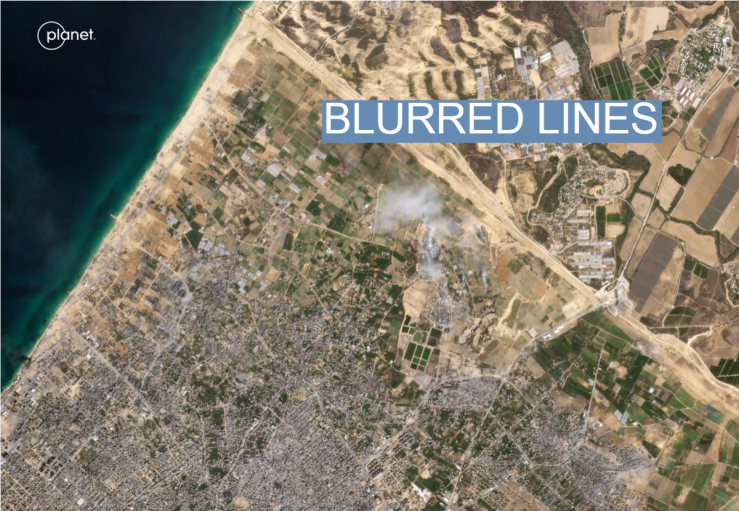The Scoop
Key providers of satellite photographs to news organizations and other researchers have begun to restrict imagery of Gaza after a New York Times report on Israeli tank positions based on the images.
The satellite image provider Planet Labs, and a handful of competitors, have revolutionized coverage of wars and disasters by giving the public access to high-resolution images that were until recently available only to government intelligence agencies.
In the early days of the invasion of Ukraine in 2021, commercial satellite companies provided some of the most compelling images and insights into how the conflict was developing on the ground, making that war the first modern conflict in which journalists, researchers, and passionate amateurs could monitor developments in the conflict in such detail.
But as Israel begins its ground invasion of Gaza, the same satellite imagery providers aren’t being as forthcoming.
Planet, a San Francisco-based company launched in 2010 by former NASA scientists, has in recent days heavily restricted and obscured parts of images over the Gaza Strip for many users, including news organizations. Last week, some images of Gaza were removed from Planet’s web application for downloading imagery, and some have been distributed to interested media outlets through a Google Drive folder. The satellite company told some subscribers that during active conflicts, it may modify pictures published to the archive.
Two Planet subscribers confirmed to Semafor that between Oct. 30 and Nov. 1, the company did not provide low or medium resolution imagery of the northern area of the Gaza Strip where much of the Israeli military activity seems to be concentrated. Additionally, subscribers have not had access through Planet’s platform to the high-resolution .50cm imagery of Gaza since Oct. 22, according to two Planet subscribers. Several subscribers showed Semafor images taken by Planet’s “Dove” satellites that showed areas around Gaza in detail, but large solid-color blocks over the coastal strip. One person familiar with the imagery said that the company is sharing medium-resolution images at an infrequent clip, and said that there have been no low- or medium-resolution images of Gaza since Friday.
Some commercial satellite companies appear to be releasing their detailed images — but with a time delay. Planet and a competitor, Maxar Technologies, have released images shared with the New York Times, Washington Post, and other news outlets on a significant time delay. Starting on Nov. 3, both papers shared exclusive images taken by Planet on Nov. 1. Airbus, another major commercial satellite image provider, has not shared images of Gaza.
Planet did not say why the company in recent days had restricted or slowed the release of images of Gaza. But commercial satellite images of the conflict have concerned U.S. security officials, according to a person familiar with the issue, who have noted the level of detail in stories such as an Oct. 19 New York Times story with images showing Israeli tank positions in Northern Gaza.
A spokesperson for the company said that while they could not comment on specific users, the company was “working through all of our crisis response processes to try to best support our customers and partners across governments, media, and humanitarian organizations.” The spokesperson further clarified that satellite imagery “must pass all quality thresholds for publication in our catalog,” and these were “standard operating protocols for our product that are not in any way specific to this region or event.”
The New York Times declined to comment. A spokesperson for the Pentagon did not return a request for comment.
In this article:
Max’s view
A new wave of private companies have revolutionized the business of space, and raced ahead of NASA and other government-run space programs around the globe. Elon Musk’s Starlink, the best-known of these, has proven crucial to the Ukrainian war effort — but also drew criticism when Musk refused to extend its coverage as far as the Ukrainians would like. Planet and other commercial satellite imagery providers that have revolutionized information collection, helping large organizations and city and state government clients to do everything from monitor crops and weather to urban planning. But now they, like Starlink, find themselves making choices about national security that have typically been made by governments, not companies.
The U.S. government has at times welcomed their role. In the leadup to the war in Ukraine, publicly available satellite imagery helped convince many skeptics that Russia was preparing to invade. Companies like Maxar have celebrated their ability to release publicly images that previously would have only been available to the military, saying they had “fundamentally changed the framing of the conflict, effectively disproving Russia’s justification for the war and exposing its forces’ most atrocious actions.”
But the situation in Gaza has proved more sensitive. People with knowledge of the internal dynamics told Semafor that there has been uncertainty at multiple satellite providers over how much information to provide. This has forced the companies into a delicate balancing act: attempting to provide useful information to eager news outlets while staying in the good graces of the federal government, which is also a major client.
Notable
- Major U.S. news organizations are relying on satellite providers that show much lower-quality images and provide less information to journalists and analysts. This week, The New York Times created an analysis of Israeli troop movements based on lower-resolution satellite imagery from Copernicus.
- Elon Musk “has sought out business opportunities in crucial areas where, after decades of privatization, the state has receded, Ronan Farrow wrote in an August New Yorker exploration of this new privately-controlled security infrastructure.
- There’s an additional legal restriction on satellite photos of Israel, Payload reported: “Under the Kyl-Bingaman Amendment (KBA), which passed in the 1997 NDAA, American companies can’t release imagery of Israel that’s at a higher resolution than what’s distributed by non-US companies.”


